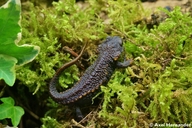|
Echinotriton andersoni (Boulenger, 1892)
Anderson’s Spiny Crocodile Newt | family: Salamandridae subfamily: Pleurodelinae genus: Echinotriton |
| Species Description: Boulenger, G. A. (1892). "Descriptions of new reptiles and batrachians from the Loo Choo Islands." Annals and Magazine of Natural History, Series 6, 10: 302–304. | |
 © 2015 Axel Hernandez (1 of 36)
|
|
|
|
Description The genus Echinotriton comprises two species, E. andersoni, endemic on five islands of the Ryukyu archipelago, Japan (Nussbaum & Brodie Jr. 1982; Nussbaum Brodie Jr & Yang 1995) and E. chinhaiensis, occurring in Zhejiang in China (Cai & Fei 1984). Echinotriton is unique among amphibian genera in having an anteriorly curved spine on the posterolateral surface of each quadrate. Echinotriton is most similar to Tylototriton, but differs in a number of significant morphological and life history features. The ribs of Echinotriton are free of muscular attachment distally, sharp-tipped, and often penetrate the skin through the primary warts. Echinotriton has a stockier body than Tylototriton, with shorter limbs, digits and tail (Inger 1947; Nussbaum & Brodie Jr. 1982). The adults are completely terrestrial and deposit their eggs on land, whereas the larvae develop in lentic water bodies. E. andersoni is closely related and very similar to the Chinese sister species E. chinhaiensis, but differs from that species in that it has rows of secondary warts running on each side of the vertebral crest, between vertebral column and the row of primary warts, supported by the ribs. Distribution and Habitat Country distribution from AmphibiaWeb's database: Japan, Taiwan
Life History, Abundance, Activity, and Special Behaviors Both males and females of this salamander lead a largely hidden terrestrial life and are difficult to observe outside the breeding season. In the reproductive season, only the females move to the oviposition sites. Males are far less numerous. Mating takes place on land and has only been observed in the laboratory (Utsunomiya 1982). The male approaches the female and deposits several spermatophores on land. The couple makes a circular movement, in the course of which the female is led over the spermatophore. Sperm may be stored in the female cloaca during at least 4 months (Utsunomiya 1982). Food consists of terrestrial Isopoda and Coleoptera, earthworms and spiders (Sato 1943). E. andersoni exhibits a stereotyped rigid anti-predator posture, during which the body is flattened and curled up and the hands and tail are raised; The species has elongated, sharp ribs with sharp epipleural processes, capable of piercing through the lateral warts (Brodie Jr et al. 1984). Trends and Threats Relation to Humans Possible reasons for amphibian decline General habitat alteration and loss Comments
References
Brodie, E.D., Jr, Nussbaum, R.A. and DiGiovanni, M. (1984). ''Antipredator adaptations of Asian salamanders (Salamandridae).'' Herpetologica, 40, 56-68. Cai, C. M. and Fei, L. (1984). ''Description of neotype of Echinotriton chinhaiensis (Chang) and its ecology and habit (In Chinese, with English abstract).'' Acta Herpetologica Sinica, 3, 71-78. Hayashi, T., Matsui, M., Utsunomiya, T.,Tanaka, S., and Ota, H. (1992). ''Allozyme variation in the newt Tylototriton andersoni from three islands of the Ryukyu archipelago.'' Herpetologica, 48., 178-184. Inger, R.F. (1947). ''Preliminary survey of the amphibians of the Riukiu islands.'' Fieldiana: Zoology, 32(5), 296-352. Japan Agency of Environment (2000). Threatened Wildlife of Japan - Red Data Book. 2nd ed. Reptilia/Amphibia. (in Japanese with English summary). Japan Wildlife Research Center, Tokyo, Japan. Kato, T. and Ota, H. (1993). Endangered Wildlife of Japan. Hoikusha, Osaka, Japan. Nussbaum, R. A., Brodie, E. D., Jr., and Datong, Y. (1995). ''A taxonomic review of Tylototriton verrucosus Anderson (Amphibia: Caudata: Salamandridae).'' Herpetologica, 51(3), 257-268. Nussbaum, R.A. and Brodie, E.D., Jr. (1982). ''Partitioning of the salamandrid genus Tylototriton Anderson (Amphibia: Caudata) with a description of a new genus.'' Herpetologica, 38, 320-332.. Ota, H. (2000). ''Current status of the threatened amphibians and reptiles of Japan.'' Population Ecology, 42, 5-9. Sato, I. (1943). A Monograph of the Tailed Batrachians of Japan (In Japanese). Nippon Shuppan-Sha, Osaka, Japan. Snider, A. and Zippel, K. (2000). ''Amphibian conservation at the Detroit Zoological Institute.'' Froglog, 40(2). Stejneger, L. (1907). Herpetology of Japan and Adjacent Territory. Government Printing Office, Washington. Reprinted 1996, with an introduction by M. Matsui. Society for the Study of Amphibians and Reptiles in cooperation with the Herpetological Society of Japan Thorn, R. (1969). Les Salamandres d'Europe, d'Asie, et d'Afrique du Nord. Lechevalier, Paris, France. Utsunomiya, T. (1982). ''Reproductive behavior of male Tylototriton andersoni observed in our laboratory (in Japanese).'' Japanese Journal of Herpetology, 9(126). Utsunomiya, Y., Utsunomiya, T. and Kawachi, S. (1978). ''Some ecological observations of Tylototriton andersoni, a terrestrial salamander occurring in the Tokunoshima Island.'' Proceedings of the Japan Academy, Series B, 54, 341-346. Zhao, E. (1998). China Red Data Book of Endangered Animals: Amphibia and Reptilia. Science Press: Endangered Species Scientific Commission, P.R.C., Beijing. Zhao, E. (1999). ''Distribution patterns of amphibians in temperate East Asia.'' Patterns of Distribution of Amphibians. A Global Perspective. Duellman, W. E., eds., Johns Hopkins University Press, Baltimore, MD, 421-443. Zhao, E. and Adler, K. (1993). Herpetology of China. Contributions to Herpetology 10. Society for the Study of Amphibians and Reptiles, in cooperation with Chinese Society for the Study of Amphibians and Reptiles, Oxford, Ohio, USA. Originally submitted by: Max Sparreboom (first posted 2000-09-26) Edited by: Arie van der Meijden (2022-01-19) Species Account Citation: AmphibiaWeb 2022 Echinotriton andersoni: Anderson’s Spiny Crocodile Newt <https://amphibiaweb.org/species/4248> University of California, Berkeley, CA, USA. Accessed Jun 6, 2025.
Feedback or comments about this page.
Citation: AmphibiaWeb. 2025. <https://amphibiaweb.org> University of California, Berkeley, CA, USA. Accessed 6 Jun 2025. AmphibiaWeb's policy on data use. |




 Raffaëlli Account
Raffaëlli Account Map of Life
Map of Life